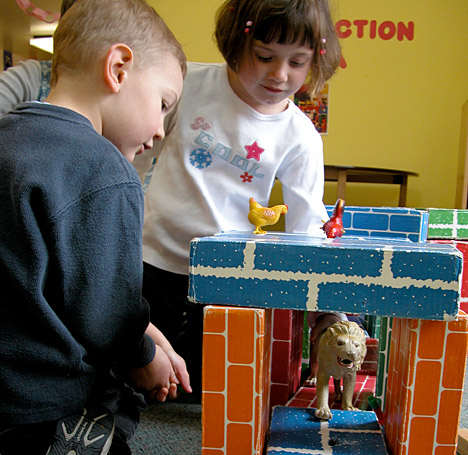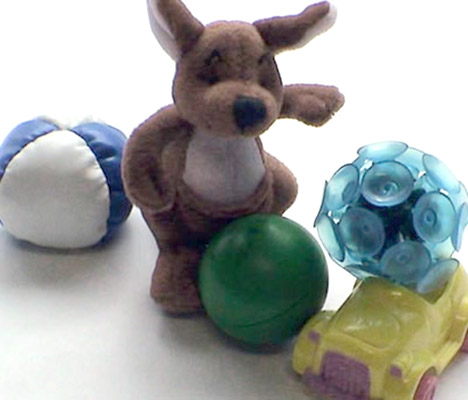
Young children often find it difficult to wait for a turn to use a toy or participate in an activity they enjoy. To a three year old, even a one-minute long wait can feel like forever. Learning to take turns is an important skill that your child will need to learn to be most successful at home, child care and school.
Here are some strategies to try to teach your child about turn taking:
Turns for Two
Start introducing the idea of waiting for a turn to your child during play. Construction, or ‘cause-and-effect’ toys and activities help your child understand when a turn is over. A “Jack in the Box” is an example of a cause and effect toy. When you press the button Jack pops out of his box.
- Block Building – Put some building blocks, or Lego in a bin or pile on the floor. Start building a block tower by taking turns to add a block to the tower. You can say the number or colour of the blocks being added to help your child learn to count and name colours as well.
- Lots of Dots – Share a marker or bingo dabber with your child and take turns making dots on a page. If your child needs support in waiting for his turn, try counting the number of dots each person gets to make during a turn. For a challenge, take turns finding and highlighting a letter in magazine or newspaper articles. For example, “Let’s find all the A’s. First it will be my turn. Then it will be Lara’s turn.”
- Computer Games – Take turns playing the “Farm Animal Sounds” game in Just for Kids section of Learning Together. Take turns clicking on the mouse. For example, “Jay, it’s your turn! Can you find the cow?”
- Train – If you have a toy train set take turns connecting pieces of the track. When the track is completed, you can take turns pushing the train along the tracks.
- Make Some Noise! – This is a great activity for music lovers! Create a shaker by pouring some beads or rice in a plastic water bottle. Seal the top of the bottle (you can use tape if you don’t want your child to open it easily). Play some upbeat music and take turns shaking it. Develop your child’s counting skills by passing the shaker after a certain number of shakes.
- Board Games – If your child has a longer attention span, simple board games such as “Candyland” are a great way to practise taking turns. If he can count, you can try “Snakes and Ladders”.
Once your child is comfortable taking short turns with you, encourage him to play turn taking games with siblings or friends.
Helping Children Wait
Young children are still developing their sense of time. They need help to understand how long “soon”, or “in a minute” really is without having to read a clock. Here are some strategies that can help your child understand how long a turn will be:
- Timers – A sand timer can be used with very short turns. When all the sand falls to the bottom your child will know it is his turn. You can set a kitchen timer for a few seconds or minutes. When the buzzer sounds it is time for your child’s turn.
- Counting – Count out loud or use your fingers. If your child can count, encourage him to join in. For example, “One…two…three… It’s Adam’s turn!”
- Music – Play or sing a short song for your child. When the song is over, it will be his turn. You can also recite a short nursery rhyme.
- Quiet Activity – Children who often become restless or impatient while waiting for others may be directed to do a quiet activity on their own such as looking at a book.
- ‘Fidget’ Toy – Your child can play with a small toy or piece of clay while waiting for his turn. This is a helpful way to keep your child busy when you need to wait.

Communicating Turns
Try to emphasize the word “turn” during daily routines at home. For example, “Sally is riding the bike. Next, it will be David’s turn.” Your child will soon understand that a turn means he has to wait until another person is finished using or doing something before he can use or do the same thing.
Use a combination of speech, gestures, and pictures to help your child learn to use the following expressions:
- “My turn” Pointing to his chest.
Pointing to the “my turn” picture in his communication book.
Practise saying the words.
- “Your turn”Pointing to or gently touching the hand of the other person.
Passing a toy to the other person.
Pointing to the “your turn” picture in his communication book.
Practise saying the words.
- Flip Card – You can create a special card to help your child during turn taking. Take a cue card, or small piece of construction paper and glue your child’s picture to one side. On the other side, glue a picture of the person he is taking turns with. You can show whose turn it is by placing the card on the table. For example, Magid’s picture is on one side of the card and Amal’s picture is on the other. When Magid’s turn is finished, he flips the card over so Amal’s can see his picture and know it is his turn.
When it is your turn, model what to do by pointing to yourself and saying, “My turn.” Another adult or older child can coach your child to communicate when it is his turn. This person can guide your child (from behind) and move his arm into position to point to himself and/or softly tell him what to say.
With practice and support, your child will be more ready to wait for his turn.
